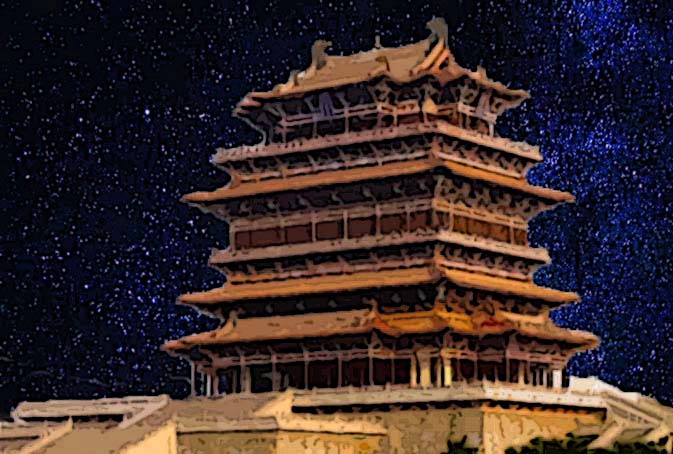In a silver bed on an icy-cold mat, dreams never come
The blue sky is misting, the clouds at night are light
From Xiao-xiang comes the cry of a wild goose–
To a twelve-story building on a moonlit night
From Xiao-Xiang, the far cry a wild goose
Wen Tingyun’s Complaint of the Jade Lute paints the picture of a lovely woman in a lonely silver bed suffering a sleepless night. A similar, but different thought — American singer, Cher, had a hit song, We All Sleep Alone, that goes:

“You got to be strong when you’re out on your own, ’cause sooner or later we all sleep alone.”
American children might picture the mouse in the animated movie, An American Tail, singing Somewhere Out there.
From far, far, faraway Xiao-Xiang, can you hear the cry of the wild goose? The unanswered question, is our goose coming or going?

Original Chinese
瑶瑟怨
冰簟銀床夢不成
碧天如水夜雲輕
雁聲遠過瀟湘去
十二樓中月自明
Notes on Translation
My unsatisfactory translation of Wen Tingyun’s poem leaves many unanswered questions.
This begins with the title Yáo sè yuàn, 瑶瑟怨, which has been variously translated as — She Sighs on Her Jade Lute, A Plaint on a Jade Zither, and Bemoaning of the Jade Lute. The alliterative Yáo sè yuàn can’t be beat, nor can it be translated easily.
Sè, 瑟 zither is a better translation, but lute is more familiar to the English ear. It has also described as a standing harp, so take your pick. The point is that the poet is plucking at our heart strings, whether it is on a lute, a zither, or a harp. Yáo, 瑶 is jade or mother of pearl, the later making more sense if one thinks of the materials going into the construction of the lute. The last character, Yuàn, 怨, means a complaint. This does not seem to me to express the grief of the girl over her absent lover. A “plea” might be better, “sigh” as suggested by another translation also captures the emotion.
First line. A cold or icy sleeping mat, a silver bed, (Yín chuáng, 銀床). an image of luxury and loneliness that long ago went out of style. A gilded bed, cold, cold silvery sheets, sleeping alone might be more familiar to western ears.
Second line. Bìtiān, 碧天 does not translate well into English. I am tempted to say “blue skies”. This only works if one think of blue skies becoming overcast and misty, and the night skies as cloudy. Moreover, Bì is that uniquely Chinese color that I seem to struggle with. It is emerald green? It is bluish-white jade-like?
Third line. In Chinese literature the wild goose represents love from afar. Du Fu also used the metaphor to refer to the absent Li Bai in his poem, Thinking of Li Bai at the End of the Sky. Xiao-xiang refers to the “lakes and rivers” along the Yangtze River in Hunan Province where Lake Dongting is located.

Fourth line. Shí’èr lóu, 十二樓 looks to be twelfth floor, but that is hard to believe. Lóu, 樓 refers to a multi-storied building or stories, so I am stuck with “twelfth floor”. And modern translations of the three characters give the same meaning.
Further Notes
Poet Li Shangyin, Wen’s contemporary, wrote an untitled poem that begins with 錦瑟無端五十弦, Jǐnsè wúduān wǔshí xián. The first two characters Jǐnsè, 錦瑟 referring to a lavishly decorated stringed instrument, again, the problem is whether it may be a zither, lute, or harp. Here we have a clue. The sentence comes out something like this —
The gorgeous harp, has no end with fifty strings.
This would put the many-stringed musical instrument in the category of a type of zither or harp.
How Tall is that Building?
I confess, after reading Andrew Wong’s illuminating translation of 瑶瑟怨, A Plaint on the Jade Zither, that 12 stories may well mean twelve (12) multi-storied buildings, and not the twelfth floor. It makes sense. There were many well-known towers in Tang China and they seemed to stop at the fifth to the seventh stories. The Wild Goose Pagoda, 大雁塔, for example, was built in 652 to a height of five stories. The Stork Tower, 鸛雀樓, pictured above was equally famous and had but three floors and four eaves. I only pause because of Qianxun Pagoda in Yunnan Province, completed in Wen’s lifetime, that has sixteen stories.











